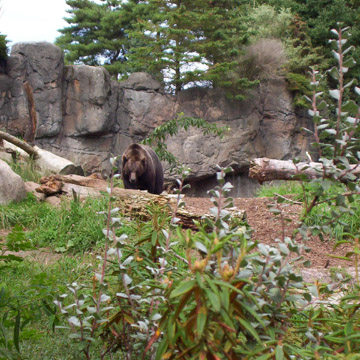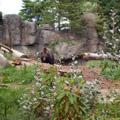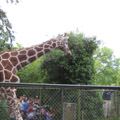Perched upon the crest of Phinney Ridge in Seattle’s Phinney Ridge neighborhood, the 92-acre Woodland Park Zoo offers visitors the opportunity to experience more than 1,000 animals of nearly 300 unique species.
Woodland Park, the 200-acre estate of Guy Carlton Phinney, was first opened to the public in 1889 and included a hotel, bandstand, ball fields, a small menagerie, and a herd of deer to attract visitors to the property. In 1890, a new streetcar line shuttled visitors to and from the nearby town of Fremont. In 1899, the City of Seattle acquired the estate from Guy’s widow, Nellie Phinney, for $5,000 in cash and the assumption of the $95,000 mortgage on the property.
Four years later, the City Parks Board retained the services of the Olmsted Brothers to create a comprehensive plan for Seattle’s open spaces. Chief planner John C. Olmsted recommended a menagerie of “hardly wild animals” and an observation tower that would allow visitors to see all of Seattle. After a collection of animals was donated to the city from the Leschi Park Zoo, the new Woodland Park Zoo opened in 1904. The zoo expanded again in 1909 to add new compounds in preparation for the Alaska-Yukon-Pacific Exposition, and the following year the Olmsted Brothers returned again to draft up detailed plans for Woodland Park.
In 1931, the Parks Board declared that most of Woodland Park should be devoted to the “Zoological Gardens of Seattle.” City and state highway engineers thought otherwise, however, and, despite opposition, implemented a plan for a new six-lane road, Aurora Avenue (Highway 99), which bisected the property and confined the zoo to the 92 acres it rests on today.
Over the years, the zoo saw little change and began to languish due to lack of funding, with the exception of voter-approved bond funds that enabled the park to make some renovations. Citizens and community leaders came to the zoo’s aide in 1965 and established the Seattle (now Woodland Park) Zoological Society to help garner more private support. These efforts paid off and in 1968 Seattle voters approved $4.5 million in bonds as part of the Forward Thrust capital improvement program. With these funds the Zoo developed its first long-range plan.
Architect G.R. Bartholick developed a proposal for the park and, in 1970, unveiled an ambitious plan to reunify Woodland Park by bridging over Aurora Avenue with a 700-foot zoological conservatory. Fearing the loss of public open space, this proposal met resistance and was defeated by a public initiative in November 1974. Subsequently, Seattle Mayor Wes Uhlman appointed a citizen task force to guide the modernization of the zoo. David Towne, the superintendent of Parks and Recreation, named David Hancocks as planning coordinator, and, in autumn 1975 Hancocks hired landscape architecture firm Jones and Jones to develop a new plan. The document aimed at rethinking zoo design based on a new set of goals that emphasized conservation, education, research, and recreation. The team developed an innovative approach by creating paths and viewing points that allowed the visitors to be immersed in the animals’ environment by hiding barriers, pens, and support areas, and presenting animals at eye level. Animals and plant species were grouped in close approximation to their native biomes, which included tropical forests; the African savanna and other large grasslands; the isolated land masses of Australasia; the Taiga, Tundra, and Montane areas of northern latitudes; and the temperate forest.
In 1976, with the City Council’s approval, Jones and Jones’s scheme became the zoo’s first master plan and established new circulation, landscaping, and land use criteria organized within an ecological framework. Many landscape architects lauded the plan, while zoo professionals had a less optimistic view as the new exhibits began construction in the summer of 1976. The initial phase of construction included the North American Marsh and Swamp exhibits (1977); the Gorilla exhibit, Primate Islands, and Lion exhibit (1979); and the zoo’s centerpiece, the African Savanna (1980). The animals thrived in their new habitats and visitors appreciated the experience of viewing the animals in a more natural setting.
By 1980 the zoo had won several awards and was ranked among the nation’s best zoos; however, due to a lack of financial resources, the implementation of the zoo’s long-range plan remained incomplete. The 1985 Zoo Bond Issue and private donations in response to the “Save Our Elephants” campaign, along with the efforts of the Woodland Park Zoological Society, enabled the construction of the final elements of the 1976 plan, including the Asian Elephant Forest exhibit (1989), Tropical Rain Forest exhibit (1992), Education Center and Northern Trail exhibit (1994), and the Tropical Asia’s Trail of Vines exhibit (1995).
The Woodland Park Zoo continues to evolve and in 2002, the City of Seattle’s Department of Parks and Recreation entered into an Operations and Management Agreement for the zoo with the Woodland Park Zoological Society, which has been instrumental in perpetuating the zoo’s mission by raising funds for the construction of new exhibits including the African Village (2001), African Wild Dog exhibit ( 2002), Jaguar Cove exhibit ( 2003), the historic carousel and Zoomazium (2006), and the Humboldt penguin exhibit (2009).
References
Crowley, Walt, McCaffrey, Marie, and Beach, Carol. The Woodland Park Zoo Guide. Seattle, WA: Woodland Park Zoological Society, 1995.
Jones and Jones and Seattle Department of Parks and Recreation. Proposed Comprehensive Plan Woodland Park Zoo. Seattle, WA: Seattle Department of Parks and Recreation, 1976.




